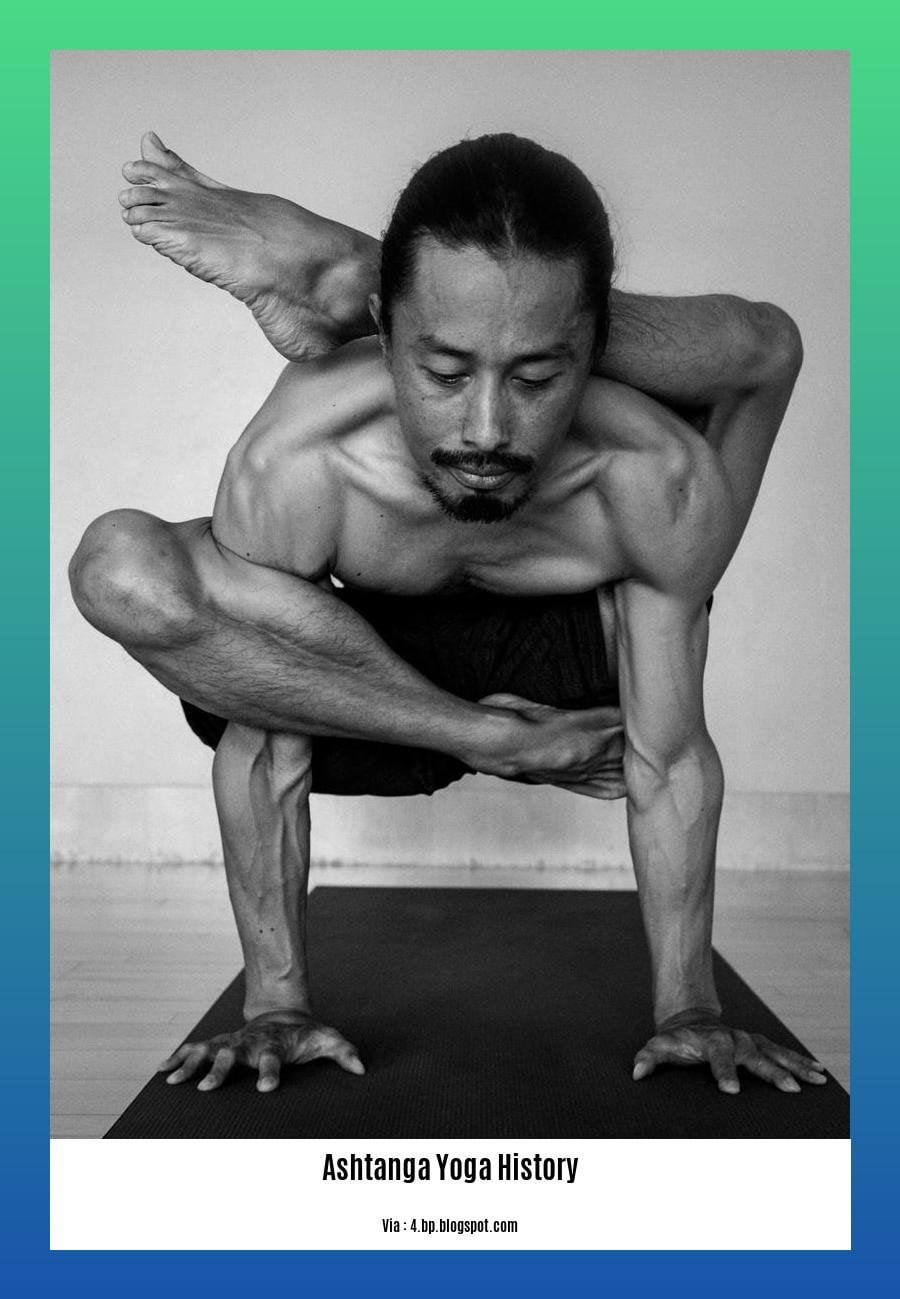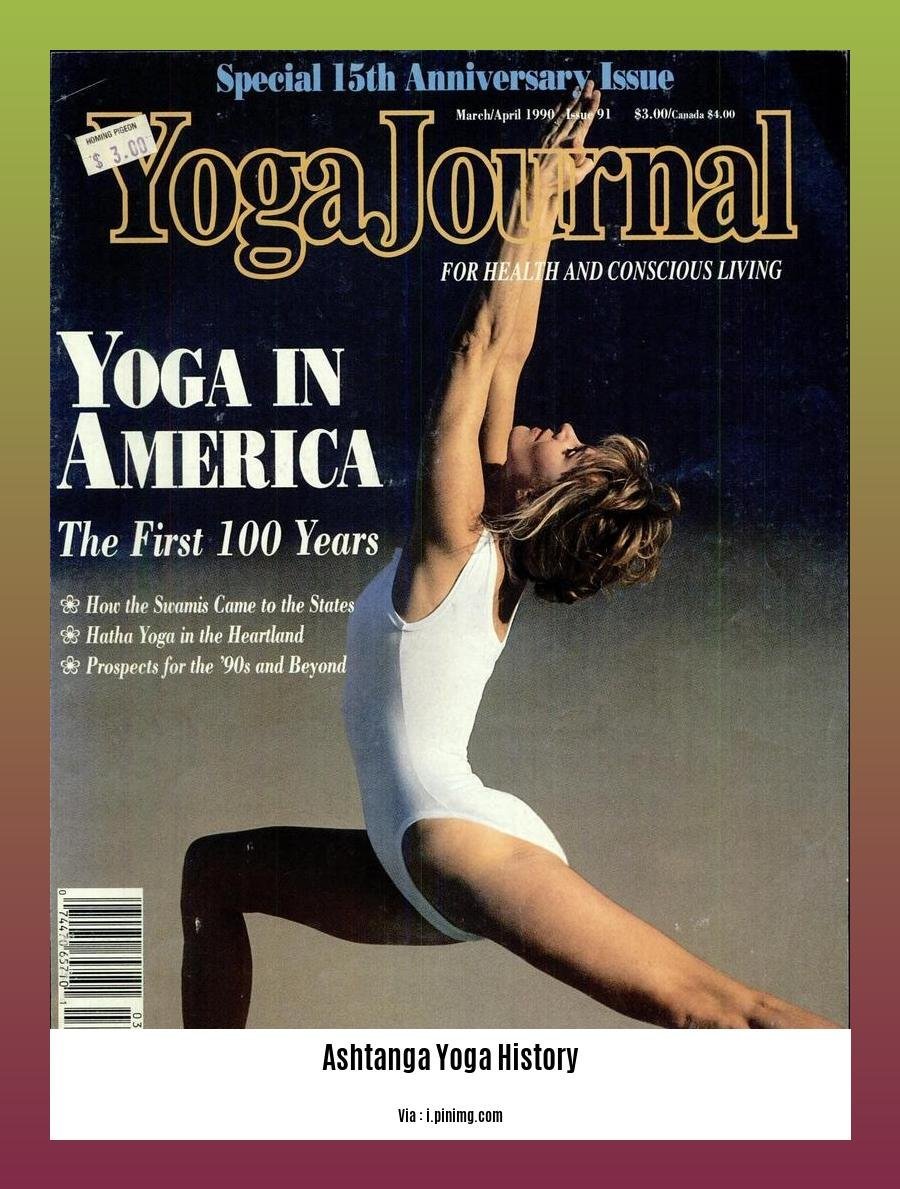Embark on a captivating journey through [Exploring the Rich Tapestry of Ashtanga Yoga History: A Journey Through Time and Transformation]. Rooted in ancient wisdom, Ashtanga yoga, a traditional form of hatha yoga popularized by Sri K. Pattabhi Jois, continues to inspire practitioners with its transformative power. Join us as we unravel the rich history of this practice, shedding light on its origins, key figures, and its enduring impact on the contemporary yoga landscape.
Key Takeaways:
Ashtanga Yoga was developed by T. Krishnamacharya for his student, K. Pattabhi Jois.
It is a vigorous style of Hatha yoga characterized by a fixed series of postures performed in a specific order.
The name “Ashtanga” means “eight limbs,” referring to the eight limbs of yoga outlined in the Yoga Sutras of Patanjali.
Key principles of Ashtanga include the use of vinyasas, or linking movements, between poses, and the practice of drishti, or gazing points.
Ashtanga Yoga offers numerous benefits, including improved flexibility, strength, balance, and endurance, as well as reduced stress and anxiety.
Ashtanga Yoga History

Ashtanga yoga, an ancient practice with a rich history, offers a unique and transformative path to physical and mental well-being. Let’s delve into its journey through time to understand its origins, evolution, and enduring influence.
How Ashtanga Yoga Was Born
The seeds of Ashtanga yoga were sown in the early 20th century by T. Krishnamacharya, a renowned yoga master who sought to revive and preserve the ancient teachings of yoga. Inspired by his guru’s teachings and his own profound experiences, Krishnamacharya developed a system of dynamic postures, known as “Vinyasa Krama,” which would later become the foundation of Ashtanga yoga.
In the 1920s, Krishnamacharya met a young student named K. Pattabhi Jois, who became his most dedicated disciple. Recognizing Jois’s potential, Krishnamacharya imparted upon him the knowledge of Vinyasa Krama and other yogic teachings.
The Legacy of Sri K. Pattabhi Jois
Under Jois’s guidance, Ashtanga yoga evolved into a codified system of eight limbs, each representing a different aspect of the practice. Jois standardized the sequence of postures, creating the primary series, intermediate series, and advanced series that are practiced today. He also introduced the concept of Mysore style, where students practice at their own pace under the guidance of a teacher.
In 1948, Jois opened the Ashtanga Yoga Research Institute in Mysore, India. This institute became a hub for Ashtanga yoga practitioners from around the world and played a pivotal role in the globalization of the practice. Jois’s teachings and charisma attracted a devoted following, and Ashtanga yoga gained widespread popularity.
Ashtanga Yoga’s Impact on Modern Yoga
Ashtanga yoga has had a profound impact on the modern yoga landscape. Known for its vigorous and dynamic style, it has become one of the most popular forms of yoga practiced worldwide. Its emphasis on breath-synchronized movement, alignment, and vinyasa has influenced many contemporary styles of yoga, such as Vinyasa flow, power yoga, and vinyasa yoga.
Ashtanga yoga’s key principles and practices have become widely adopted in the yoga community. Its focus on self-discipline, self-study, and the development of a strong and flexible body has inspired and transformed millions of practitioners around the globe.
Ashtanga Yoga is one of the most prominent types of Yoga, but uncover the secrets of the 4d past history that predates its name.
Ashtanga Yoga Origins: A Historical Unveiling

From its humble beginnings in Mysore, India, to its global recognition as a transformative practice, Ashtanga yoga’s journey is a testament to its enduring power. Join us as we delve into the ashtanga yoga origins, tracing the lineage of this dynamic practice that has captivated yogis worldwide.
Key Takeaways:
- Ashtanga yoga traces its roots to the teachings of T. Krishnamacharya, a renowned yoga master from Mysore, India.
- Krishnamacharya is widely credited with reviving the ancient practice of yoga and developing the Ashtanga system as we know it today.
- K. Pattabhi Jois, a dedicated student of Krishnamacharya, played a pivotal role in popularizing Ashtanga yoga globally.
- Jois codified the Ashtanga system into a structured series of postures, known as the Ashtanga Vinyasa system.
- The practice emphasizes a vigorous and synchronized flow of breath and movement, creating a transformative experience for practitioners.
The Legacy of T. Krishnamacharya: The Visionary Pioneer
T. Krishnamacharya, often referred to as the “Father of Modern Yoga,” was a true visionary in the world of yoga. His teachings encompassed a holistic approach, emphasizing the importance of physical postures, breathing techniques, and meditation.
It was under Krishnamacharya’s tutelage that Ashtanga yoga took shape. He imparted this dynamic practice to a select group of students, including K. Pattabhi Jois, who would later become its most prominent ambassador.
K. Pattabhi Jois: The Ashtanga Envoy
K. Pattabhi Jois, a dedicated student of Krishnamacharya, emerged as the driving force behind the global dissemination of Ashtanga yoga. Jois refined and systematized the practice, codifying it into the Ashtanga Vinyasa system.
Through his rigorous teaching and tireless efforts, Jois introduced Ashtanga yoga to the Western world, capturing the attention of yoga enthusiasts worldwide. His legacy lives on through the numerous students he trained, who have carried the torch of Ashtanga yoga to every corner of the globe.
The Essence of Ashtanga Yoga: A Dynamic Flow
At the heart of Ashtanga yoga lies a vigorous and synchronized flow of breath and movement. This dynamic practice consists of a set series of postures, performed in a specific order and linked together by continuous vinyasas, or transitions.
The fast-paced nature of Ashtanga yoga generates intense heat, which purifies the body and releases toxins. This purifying process, combined with the rhythmic breathing techniques, leads to a profound cleansing effect on both the physical and mental levels.
The Enduring Legacy of Ashtanga Yoga
Ashtanga yoga has left an indelible mark on the modern yoga landscape. Its emphasis on physical rigor, mental focus, and self-discipline has inspired and transformed countless practitioners around the world.
The practice has evolved over the years, with various styles and interpretations emerging. However, the essence of Ashtanga yoga remains unchanged: a powerful practice that cultivates physical strength, mental clarity, and a deep connection to the inner self.
Citations:
FAQ
Q1: What is the origin of Ashtanga Yoga?
A1: Ashtanga Yoga was developed by T. Krishnamacharya in the early 20th century and popularized by his student, K. Pattabhi Jois.
Q2: What does the term “Ashtanga” mean?
A2: “Ashtanga” is derived from the Sanskrit words “Ashta,” meaning eight, and “Anga,” meaning limb or body part, referring to the eight limbs of yoga outlined in the Yoga Sutras.
Q3: Is Ashtanga Yoga suitable for beginners?
A3: Ashtanga Yoga is a demanding and physically challenging practice, requiring strength, flexibility, and endurance. It is typically not recommended as a beginner’s yoga style.
Q4: What are the potential benefits of Ashtanga Yoga?
A4: Practicing Ashtanga Yoga offers numerous benefits, including increased flexibility, strength, balance, and endurance, as well as improved mental focus, stress reduction, and overall well-being.
Q5: Are there any variations or modifications in Ashtanga Yoga?
A5: While Ashtanga Yoga is traditionally taught in a Mysore-style setting with a set series of postures, there are variations and modifications available to suit individual needs and abilities, making the practice accessible to a wide range of practitioners.















